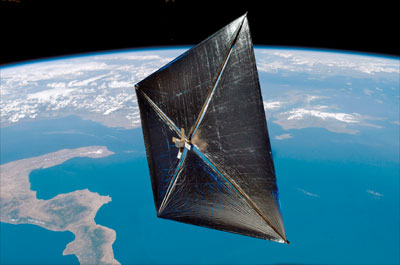|
|

|
|
Author
|
Topic: NASA's NanoSail-D nanosatellite and FASTSAT
|
Robert Pearlman
Editor Posts: 42988
From: Houston, TX
Registered: Nov 1999
|
 posted 12-19-2010 11:04 AM
posted 12-19-2010 11:04 AM
   
On Dec. 6, NASA announced that its NanoSail-D had become the first successfully ejected nanosatellite from a free-flying microsatellite (Fast, Affordable, Science and Technology Satellite or FASTSAT), demonstrating the capability to deploy a small cubesat payload from an autonomous microsatellite in space. Nanosatellites or cubesats are typically launched and deployed from a mechanism called a Poly-PicoSatellite Orbital Deployer (P-POD) mounted directly on a launch vehicle. This is the first time NASA has mounted a P-POD on a microsatellite to eject a cubesat. FASTSAT, equipped with six science and technology demonstration payloads, including NanoSail-D, launched Friday, Nov. 19 at 8:25 p.m. EST from Kodiak Island, Alaska. During launch, the NanoSail-D flight unit, about the size of a loaf of bread, was stowed inside FASTSAT in a P-POD.  "The successful ejection of NanoSail-D demonstrates the operational capability of FASTSAT as a cost-effective independent means of placing cubesat payloads into orbit safely," said Mark Boudreaux, FASTSAT project manager at the Marshall Space Flight Center in Huntsville, Ala. "With this first step behind us, we have demonstrated we can launch a number of different types of payloads using this common deployment system from an autonomous microsatellite like FASTSAT."
Almost two weeks later, it now looks like NanoSail-D never ejected. At this time, it is not clear that NanoSail-D ejected from the Fast, Affordable, Science and Technology Satellite (FASTSAT) as originally stated on Monday, Dec. 6. At the time of ejection, spacecraft telemetry data showed a positive ejection as reflected by confirmation of several of the planned on orbit ejection sequence events. The FASTSAT spacecraft ejection system data was also indicative of an ejection event. NanoSail-D was scheduled to unfurl on Dec. 9 at 12:30 a.m., and deployment hasn't been confirmed. The FASTSAT team is continuing to trouble shoot the inability to make contact with NanoSail-D. The FASTSAT microsatellite and all remaining five onboard experiments continue to operate as planned.
Had NanoSail-D deployed, it was to demonstrate the use of its large sail made of thin polymer material to significantly decrease the time to de-orbit the small satellite without the use of propellants as most traditional satellites use. |
Robert Pearlman
Editor Posts: 42988
From: Houston, TX
Registered: Nov 1999
|
 posted 01-21-2011 10:03 PM
posted 01-21-2011 10:03 PM
   
NASA release NASA's First Solar Sail NanoSail-D Deploys in Low-Earth OrbitFriday, Jan. 21 at 10 a.m. EST, engineers at NASA's Marshall Space Flight Center in Huntsville, Ala., confirmed that the NanoSail-D nanosatellite deployed its 100-square-foot polymer sail in low-Earth orbit and is operating as planned. Actual deployment occurred on Jan. 20 at 10 p.m. EST and was confirmed today with beacon packets data received from NanoSail-D and additional ground-based satellite tracking assets. In addition, the NanoSail-D orbital parameter data set shows an appropriate change which is consistent with sail deployment. "This is tremendous news and the first time NASA has deployed a solar sail in low-Earth orbit," said Dean Alhorn, NanoSail-D principal investigator and aerospace engineer at the Marshall Center. "To get to this point is an incredible accomplishment for our small team and I can't thank the amateur ham operator community enough for their help in tracking NanoSail-D. Their assistance was invaluable. In particular, the Marshall Amateur Radio Club was the very first to hear the radio beacon. It was exciting!" NanoSail-D will continue to send out beacon signals until the onboard batteries are expended and can be found at 437.270 MHz. It can be tracked on the NanoSail-D dashboard. It is estimated that NanoSail-D will remain in low-Earth orbit between 70 and 120 days, depending on atmospheric conditions. NanoSail-D is designed to demonstrate deployment of a compact solar sail boom technology. This research demonstration could lead to further advances of this alternative solar sail propulsion and the critical need for new de-orbit technologies. This ejection experiment also demonstrates a spacecraft’s ability, like the Fast, Affordable, Science and Technology Satellite, or FASTSAT, to eject a nano-satellite from a micro-satellite, while avoiding re-contact with the primary satellite. "This is a significant accomplishment for both the FASTSAT and NanoSail-D projects. This accomplishment validates that we've met another of our primary mission objectives -- successfully ejecting a nanosatellite from an orbiting microsatellite," said Mark Boudreaux, FASTSAT project manager at the Marshall Center. "This is another significant accomplishment for our inter Agency, Industry and Governmental FASTSAT-HSV01 partnership team." |
gliderpilotuk
Member Posts: 3398
From: London, UK
Registered: Feb 2002
|
 posted 01-22-2011 05:26 AM
posted 01-22-2011 05:26 AM
   
And if you have the Flyby App on your iPhone it told you this morning that the NanoSail is visible at high elevation from the UK at 17:33 this evening... but it's going to be cloudy.  | |
Contact Us | The Source for Space History & Artifacts
Copyright 2020 collectSPACE.com All rights reserved.

Ultimate Bulletin Board 5.47a
|
|

|
 advertisement advertisement

|













